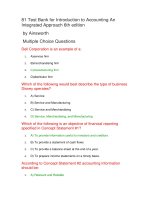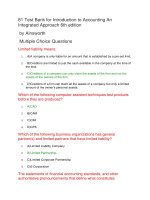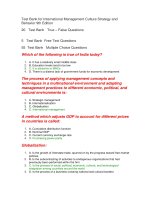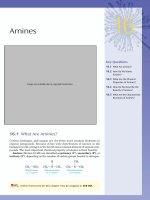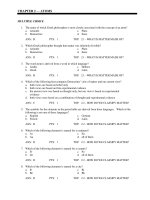Test bank for introduction to general organic and biochemistry 9th edition by bettelheim
Bạn đang xem bản rút gọn của tài liệu. Xem và tải ngay bản đầy đủ của tài liệu tại đây (388.16 KB, 14 trang )
Link full download: />
Test Bank for Introduction to General Organic and Biochemistry 9th
Edition by Bettelheim
CHAPTER 10 — ORGANIC CHEMISTRY Key
1. Which element accounts for the largest percentage of the earth’s crust?
A.carbon
B. nitrogen
C. oxygen
D. silicon
2. Which of the following statements is false?
A.organic chemistry involves the study of compounds which contain carbon
B. organic compounds cannot be synthesized in the laboratory
C. the most common elements found in organic compounds are carbon,
hydrogen, nitrogen and oxygen
D. organic and inorganic compounds obey the same natural laws
3. Approximately how many new organic compounds are reported each year?
A.1000
B. 10,000
C. 100,000
D. 1,000,000
4. Chemicals in which of the following groups are not considered organic
chemicals?
A.enzymes
B. minerals
C. proteins
D. vitamins
5. Which of the following is generally true of most organic compounds?
A.their bonding is covalent in nature
B. their aqueous solutions conduct electricity
C. both (a) and (b)
D. neither (a) nor (b)
6. Which of the following is generally true of organic compounds?
A.they are typically high melting solids
B. most are soluble in water
C. both (a) and (b)
D. neither (a) nor (b)
7. Which of the following is true of organic compounds?
A.most are gases, liquids or low melting solids
B. they represent only 5% of all known compounds
C. both (a) and (b)
D. neither (a) nor (b)
8. Which of the following chemicals, when pure, will have different properties if
it is synthesized in the laboratory than if it is obtained from a natural source?
A.ethanol
B. taxol
C. vitamin C
D. none of these
9. A chemist has two pure samples of an organic compound, one of which she
obtained from a natural source, and one of which she synthesized in the lab.
Which of the following properties can she use to determine which is the
synthetic sample?
A.boiling point
B. formula weight
C. solubility
D. none of these
10. Which of the following statements about organic compounds is true?
A.only naturally occurring compounds are considered organic compounds
B. the number of naturally occurring compounds and the number of synthetic
compounds are approximately equal
C. the number of naturally occurring compounds greatly exceeds the number
of synthetic compounds
D. the number of naturally occurring compounds is much smaller than the
number of synthetic compounds
11. Which of the following statements about taxol is false?
A.about 1 gram can be obtained from a 100 year old tree
B. it is effective in treating certain ovarian and breast cancers
C. taxol synthesized in the laboratory is identical to naturally obtained taxol
D. none, all of the above are true
12. Which of the following statements about taxol is false?
A.taxol is no longer obtained primarily from the bark of the Pacific yew
B. taxol and paclitaxel are two different but related anticancer drugs
C. taxol has been successfully synthesized by chemists
D. taxol inhibits cell division by preventing the disassembly of microtubules
13. Which of the following geometries is never associated with a carbon atom in
an organic compound?
A.linear
B. square planar
C. tetrahedral
D. trigonal planar
14. If the bond angles at a carbon atom are 109.5°, how many groups are
distributed around the carbon atom?
A.1
B. 2
C. 3
D. 4
15. If the bond angles at a carbon atom are 120°, how many groups are
distributed around the carbon atom?
A.1
B. 2
C. 3
D. 4
16. If the bond angle at a carbon atom is 180°, how many groups are distributed
around the carbon atom?
A.1
B. 2
C. 3
D. 4
17. In organic compounds, which of the following elements normally forms three
covalent bonds?
A.carbon
B. hydrogen
C. nitrogen
D. oxygen
18. In organic compounds, which of the following elements normally forms two
covalent bonds?
A.carbon
B. hydrogen
C. nitrogen
D. oxygen
19. The bond angles around the carbon atom in methane (CH4) are all:
A.180o
B. 120o
C. 109.5o
D. 90o
20. The chemical formula of methylamine is CH3NH2. How many valence
electrons are associated with a molecule of methylamine?
A.7
B. 8
C. 12
D. 14
21. The chemical formula of methylamine is CH3NH2. How many unshared
electron pairs are associated with a molecule of methylamine?
A.1
B. 2
C. 8
D. 14
22. The chemical formula of methanol is CH3OH. How many unshared electron
pairs are associated with a molecule of methanol?
A.1
B. 2
C. 4
D. 6
23. The chemical formula of acetylene is C2H2. How many valence electrons are
associated with a molecule of acetylene?
A.4
B. 5
C. 8
D. 10
24. The chemical formula of hydrogen cyanide is HCN. How many valence
electrons are associated with a molecule of hydrogen cyanide?
A.4
B. 6
C. 10
D. 14
25. The chemical formula of hydrogen cyanide is HCN. How many unshared
electrons are associated with a molecule of hydrogen cyanide?
A.2
B. 4
C. 6
D. 10
26. Which of the following functional groups does not contain a carbonyl group?
A.ester
B. alcohol
C. aldehyde
D. ketone
27. In which of the following classes of organic compounds is an oxygen atom
bonded to a hydrogen atom?
A.alcohols
B. aldehydes
C. amines
D. all of these
28. In which of the following classes of organic compounds is an oxygen atom
bonded to a hydrogen atom?
A.aldehydes
B. carboxylic acids
C. ketones
D. all of these
29. In which of the following classes of organic compounds must there be at least
two oxygen atoms?
A.alcohols
B. aldehydes
C. carboxylic acids
D. ketones
30. In which of the following classes of organic compounds must there be at least
two oxygen atoms?
A.carboxylic acids
B. carboxylic esters
C. both (a) and (b)
D. neither (a) nor (b)
31. In which of the following classes of organic compounds must there be at least
two oxygen atoms?
A.carboxylic esters
B. ketones
C. both (a) and (b)
D. neither (a) nor (b)
32. In which of the following classes of organic compounds must every compound
contain more than one carbon atom?
A.alcohols
B. aldehydes
C. carboxylic acids
D. ketones
33. Which of the following classes of compounds can be categorized as primary,
secondary, or tertiary?
A.alcohols
B. aldehydes
C. carboxylic acids
D. ketones
34. Which of the following classes of compounds can be categorized as primary,
secondary or, tertiary?
A.aldehydes
B. amines
C. carboxylic acids
D. ketones
35. What is the minimum number of hydrogen atoms present in a carboxylic
acid?
A.1
B. 2
C. 3
D. 4
36. What is the minimum number of hydrogen atoms present in a carboxylic
ester?
A.1
B. 2
C. 4
D. 6
37. The group is the functional group of which of the following types of
compounds?
A. carboxylic acids
B. aldehydes
C. carboxylic esters
D. ketones
38. Amino acids are molecules which contain both an amino group and a carboxyl
group. Which atomic species must be present in all amino acids?
A.C and H
B. C, H and N
C. C, H and O
D. C, H, N and O
39. Amino acids are molecules which contain both an amino group and a carboxyl
group. Proteins are made up of a-amino acids which, except for proline, have
the general formula NH2-CHR-COOH where the R group determines the
identity of the amino acid. Which of the following is true of the amino group
in a-amino acids?
A.it is always 1°
B. it is always 2°
C. it is always 3°
D. it is 1°, 2° or 3° depending on the identity of R
40. Compounds known as a-hydroxycarboxylic acids are found in many
cosmetics. These compounds contain both a hydroxyl group and a carboxyl
group. What is the minimum number of oxygen atoms present in an ahydroxycarboxylic acid?
A.1
B. 2
C. 3
D. 4
41. Which of the following statements is false?
A.in a secondary amine, the nitrogen is bonded to two carbon atoms
B. in a tertiary alcohol, the carbon bearing the OH group is bonded to no
hydrogen atoms
C. aldehydes, ketones and esters all contain a carbonyl group
D. the molecular formula for the smallest carboxylic acid is C2H4O2
42. Of the four alcohols with molecular formula C4H10O, how many are primary
alcohols?
A.1
B. 2
C. 3
D. 4
43. How many amines have the molecular formula C3H9N?
A.1
B. 2
C. 3
D. 4
44. How many aldehydes have the molecular formula C4H8O?
A.1
B. 2
C. 3
D. 4
45. How many secondary amines have the molecular formula C4H11N?
A.1
B. 2
C. 3
D. 4
46. How many ketones have the molecular formula C5H10O?
A.1
B. 2
C. 3
D. 4
47. How many carboxylic acids have the molecular formula C4H8O2?
A.1
B. 2
C. 3
D. 4
48. How many carboxylic esters have the molecular formula C3H6O2?
A.1
B. 2
C. 3
D. 4
49. Which of the following is an example of a secondary alcohol?
A.CH3OH
B. CH3CH2OH
C. CH3CH2CH2OH
D. none of these
50. Which of the following is an example of a secondary alcohol?
A.CH3OH
B.
C. CH3CH2OH
D. none of these
51. Which of the following is an example of a tertiary alcohol?
A.CH3OH
B. CH3CH2OH
C. CH3CH2CH2OH
D. none of these
52. Which of the following is an example of a primary amine?
A.CH3NH2
B. CH3CH2NH2
C. CH3CH2CH2NH2
D. all of these
53. Which of the following is an example of a secondary amine?
A.CH3NH2
B. CH3CH2NH2
C. CH3CH2CH2NH2
D. none of these
54. Which of the following is an example of a secondary amine?
A.CH3NH2
B. CH3CH2NH2
C. CH3CH2NHCH3
D. none of these
55. Which of the following is an example of a tertiary amine?
A.CH3NH2
B. CH3CH2NH2
C. CH3CH2CH2NH2
D. none of these
56. Which of the following is an example of a secondary amine?
A.CH3CH2NH2
B. CH3CH2CH2NHCH3
C.
D. none of these
57. Which of the following is an example of a secondary amine?
A.CH3NH2
B.
C.
D. none of these
58. Which of the following is an example of a tertiary amine?
A.CH3NH2
B.
C.
D. none of these
59. Which of the following is an example of a carboxylic ester?
A.CH3COOH
B. CH3CH2OH
C. CH3CHO
D.
60. Which of the following is an example of a carboxylic acid?
A.CH3CH2OH
B.
C.
D.
61. Which of the following is an example of a carboxylic acid?
A.
B.
C. both (a) and (b)
D. neither (a) nor (b)
62. Which of the following is an example of a carboxylic acid?
A.
B.
C. both (a) and (b)
D. neither (a) nor (b)
63. Which of the following is an example a carboxylic ester?
A.CH3CH2OH
B.
C.
D.
64. Which of the following is an example a carboxylic ester?
A.
B.
C. both (a) and (b)
D. neither (a) nor (b)

